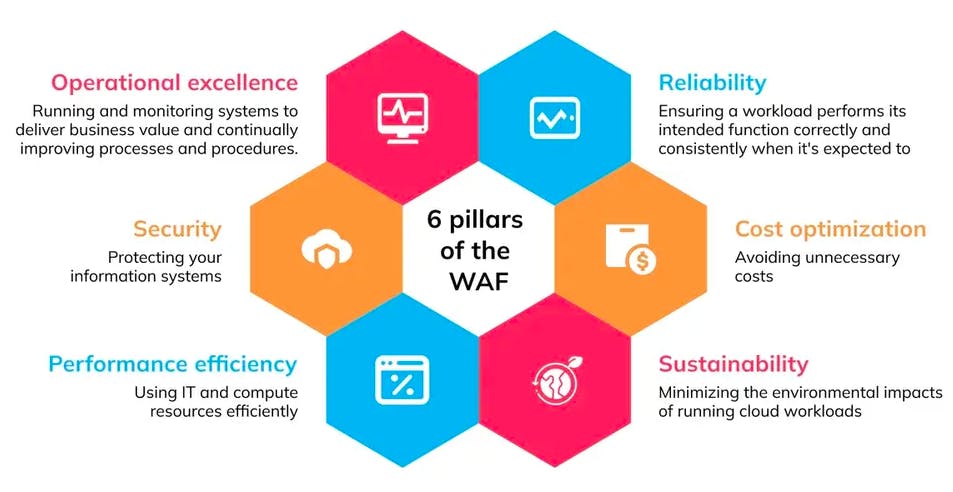Designing Resilient Systems with the AWS Well-Architected Framework
A Comprehensive Guide to Building Robust and Efficient Cloud Architectures using the AWS Well-Architected Framework!
In today's digital era, building robust, reliable, and efficient cloud architectures is essential for any business to thrive. Amazon Web Services (AWS) provides a powerful framework to guide organizations in creating resilient cloud solutions using the AWS Well-Architected Framework. This framework encompasses a set of core principles and best practices designed to help you construct the most secure, high-performing, and efficient cloud infrastructure possible for your applications and workloads.
What is the AWS Well-Architected Framework? 🛡️
The AWS Well-Architected Framework is a comprehensive guide developed by AWS based on extensive customer architecture reviews. It serves as a blueprint for building cloud architectures that excel in areas such as operational excellence, security, reliability, performance efficiency, cost optimization, and sustainability.
The Six Pillars of the AWS Well-Architected Framework

Operational Excellence: This pillar focuses on delivering business value through efficient operation and continuous improvement of processes and procedures. It emphasizes automating changes, responding to events, and defining standards for daily operations.
Security: Security is paramount in the cloud. This pillar provides guidance on protecting data, systems, and assets while delivering business value. It includes principles like a strong identity foundation, enabling traceability, and applying security at all layers.
Reliability: The reliability pillar ensures that workloads consistently perform their intended functions and recover quickly from failures. Key strategies include automatically recovering from failure, testing recovery procedures, scaling horizontally, stopping guessing capacity, and managing change through automation.
Performance Efficiency: This pillar focuses on using IT and computing resources efficiently to meet system requirements and maintain efficiency as demand changes. Strategies encompass democratizing advanced technologies, going global in minutes, using serverless architectures, experimenting more often, and considering mechanical sympathy.
Cost Optimization: Cost optimization involves understanding and controlling expenses by selecting the right resource types, analyzing spending over time, and scaling resources efficiently. Principles include implementing cloud financial management, adopting a consumption model, measuring overall efficiency, stopping spending on undifferentiated heavy lifting, and analyzing and attributing expenditure.
Sustainability: Added in 2021, the sustainability pillar addresses minimizing the environmental impacts of running cloud workloads. Although not covered in this article, sustainability emphasizes eco-friendly practices to reduce the carbon footprint associated with cloud operations.
Implementing Resilience within the Framework
The AWS Well-Architected Framework encourages a holistic approach to building resilient architectures. Here are some key considerations and strategies for achieving resilience within the framework using the Six Pillars:
1. Operational Excellence
Perform Operations as Code: Define and update your entire workload as code. Automate operations procedures to respond to events automatically and limit human error.
Make Frequent, Small, Reversible Changes: Design your workload for regular, small changes that can be easily reversed if necessary.
Refine Operations Procedures Frequently: Continuously improve operations procedures as your workloads evolve. Conduct regular game days to validate procedures and ensure teams are well-prepared.
Anticipate Failure: Identify potential sources of failure, test failure scenarios, and validate your response procedures through regular testing.
Learn from All Operational Events and Failures: Foster a culture of learning from operational events and failures and share insights across teams.
2. Security
Implement a Strong Identity Foundation: Enforce the principle of least privilege, separate duties, and centralize privilege management. Reduce reliance on long-term credentials.
Enable Traceability: Monitor, alert, and audit actions and changes in real-time. Integrate logs and metrics for automatic responses.
Apply Security at All Layers: Implement defence in depth by applying security controls at all levels of your architecture.
Automate Security Best Practices: Automate security mechanisms and controls defined and managed as code.
Protect Data in Transit and at Rest: Classify data by sensitivity and use encryption, tokenization, and access control as needed.
Prepare for Security Events: Establish an incident management process aligned with organizational requirements. Conduct incident response simulations and use automation for detection, investigation, and recovery.
3. Reliability
Automatically Recover from Failure: Monitor systems for key performance indicators and configure automated recovery processes. Test your systems to simulate and correct failure pathways.
Test Recovery Procedures: Validate your recovery procedures by simulating different failure scenarios and automating their testing.
Scale Horizontally: Replace single large resources with multiple smaller ones to reduce the impact of single points of failure.
Stop Guessing Capacity: Monitor demand and automate resource addition or removal to match demand.
Manage Change in Automation: Use automation to make infrastructure changes and manage automation changes effectively.
4. Performance Efficiency
Democratize Advanced Technologies: Consume technologies as services to focus on product development.
Go Global in Minutes: Deploy systems in multiple AWS Regions for lower latency and a better customer experience.
Use Serverless Architectures: Remove operational burdens by using serverless architectures for traditional compute activities.
Experiment More Often: Perform comparative testing of different resource types, storage, or configurations.
Consider Mechanical Sympathy: Align your technology approach with your goals and data access patterns.
5. Cost Optimization
Implement Cloud Financial Management: Invest in cloud financial management and cost optimization to become a cost-efficient organization.
Adopt a Consumption Model: Pay only for the computing resources you require, increasing or decreasing usage based on business needs.
Measure Overall Efficiency: Evaluate the business output and costs associated with delivering it to optimize resource usage.
Stop Spending on Undifferentiated Heavy Lifting: Allow AWS to handle infrastructure tasks, so you can focus on customer-centric projects.
Analyze and Attribute Expenditure: Accurately identify system usage and costs and attribute IT costs to individual workload owners.
Conclusion
The AWS Well-Architected Framework is your guide to building resilient, secure, and efficient cloud architectures. By following its principles and best practices, you can create systems that excel in operational excellence, security, reliability, performance efficiency, cost optimization and sustainability. These resilient architectures not only meet the demands of today's digital landscape but also prepare your organization for a future where cloud technology plays a central role in business success. Embrace the AWS Well-Architected Framework, and you'll be on the path to cloud excellence.🚀🌿